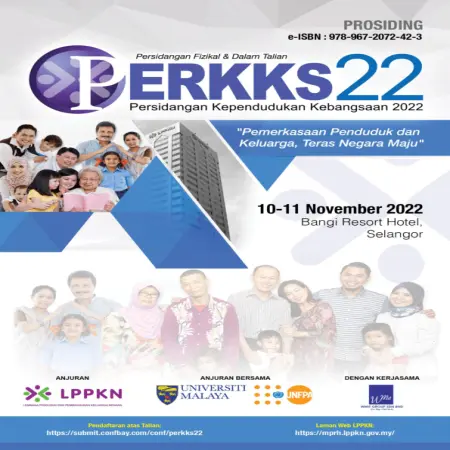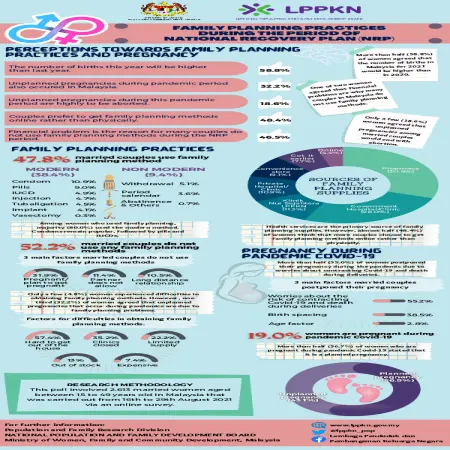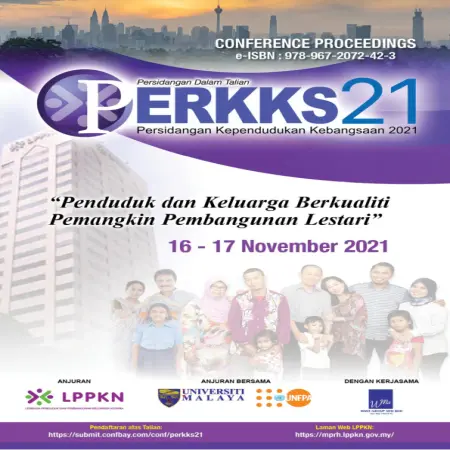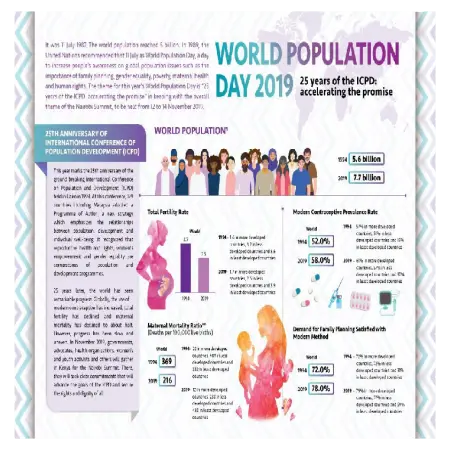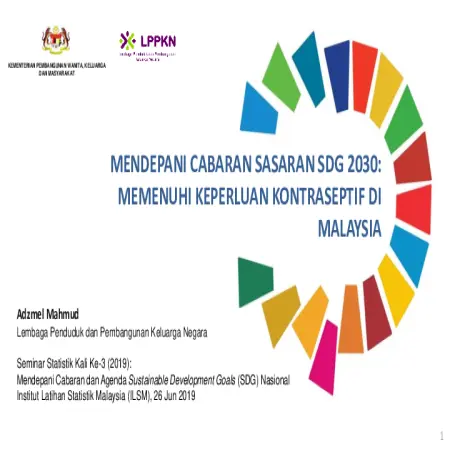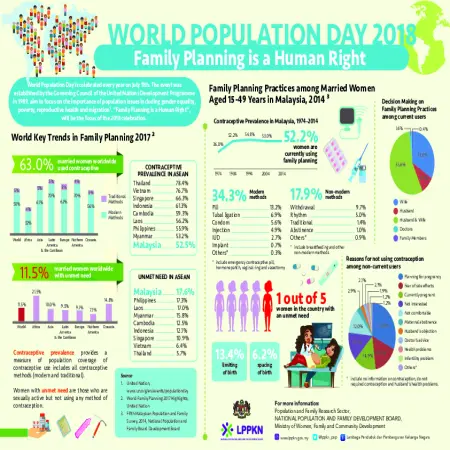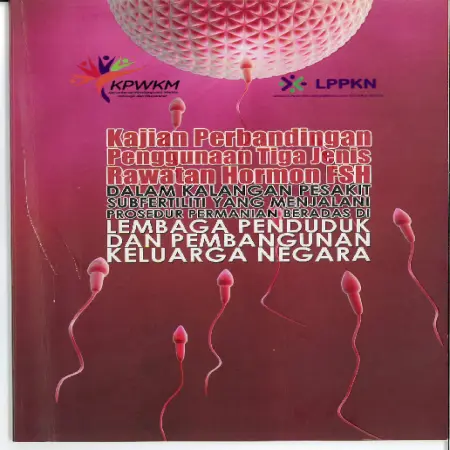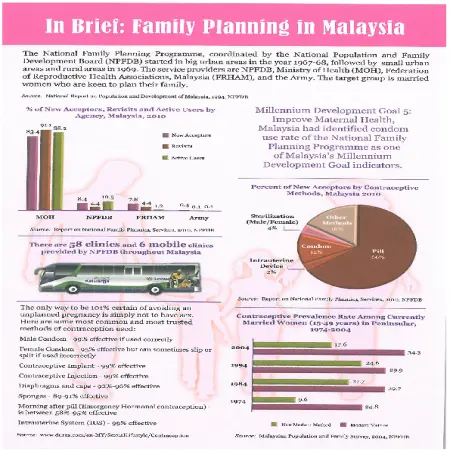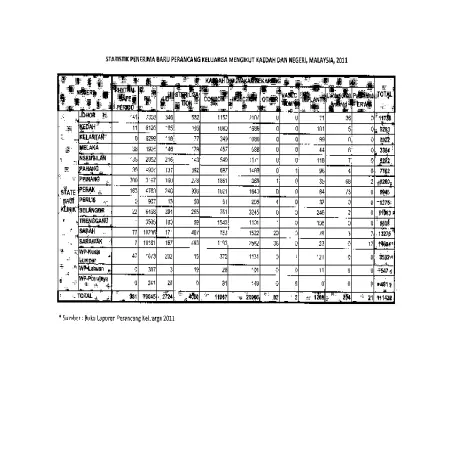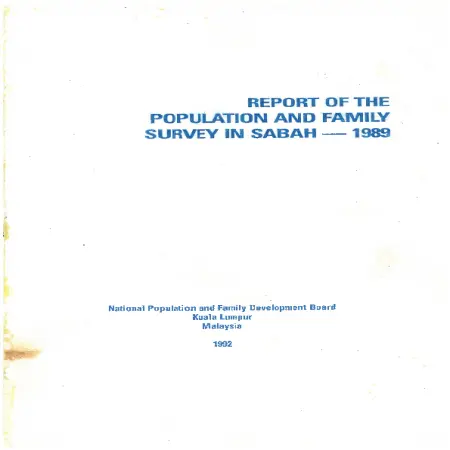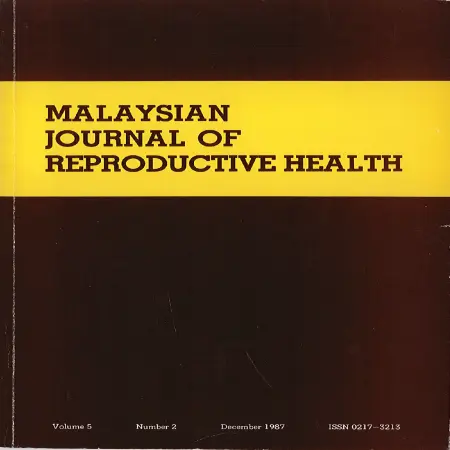TOPICS
Results for Topics : "Contraception"
2023 (1)
|
|
Descriptive analysis : family planning method in Klinik Nur Sejahtera (National Population and Family Development Board Malaysia) in the year 2018 – 2022
Item Type: Book Section
Editor:
Year: 00/12/2023
Abstract: Family planning (FP) is a component of sexual and reproductive health (SRH) and refers to the human right of individuals to regulate the number and spacing of birth. In Malaysia, contraceptive prevalence rate (CPR) during the past three decades has remained stagnant, with only 34-35% of women practicing modern contraception, this number relatively low compared to global rate and neighboring countries (Najimudeen, 2014).
|
|
|
|
2022 (5)
|
|
Prosiding Persidangan Kependudukan Kebangsaan 2022 (PERKKS 22): “Pemerkasaan Penduduk dan Keluarga, Teras Negara Maju”
Item Type: Book
Editor:
Year: 00/12/2022
Abstract: Collection of papers presented during the 2022 National Population Conference (PERKKS 22), 10-11 November 2022, Bangi Resort Hotel, Selangor.
|
|
|
|
|
|
Dasar dan Pelan Tindakan Pendidikan Kesihatan Reproduktif dan Sosial Kebangsaan (PEKERTI) 2022-2025
Item Type: Act & Policy
Editor:
Year: 08/09/2022
Abstract: This new PEKERTI policy is applicable to every individual regardless of age and gender and takes into account ethnic, religious and cultural diversity. Focus will be given to producing a healthy population in terms of reproductive and sexual health based on high moral values and practicing responsible behavior and mutual respect for each other.
This PEKERTI policy has been streamlined to achieve 5 objectives which are to (i) increase the awareness of Malaysians regarding the importance of reproductive and social health education, (ii) develop evidence-based reproductive and social health education programs, (iii) develop human expertise and modernity in aspects reproductive and social health education, (iv) carry out research in aspects of reproductive and social health education and (v) ensure programs and services under this policy are continuously monitored and evaluated.
In order to achieve these 5 objectives that have been set, 5 Cores have been identified as policy implementation machinery namely (i) Advocacy, Promotion and Prevention, (ii) Comprehensive Reproductive and Social Health Education Covering All Age Levels, (iii) Human Capital and other Resources for Reproductive and Social Health education, (iv) Research and Development and (v) Monitoring and Evaluation.
|
|
|
|
|
|
Statistik data perkhidmatan perancang keluarga LPPKN tahun 2015-2019
Item Type: Report
Editor:
Year: 00/00/2022
Abstract: National Population and Family Development Board Malaysia (NPFDB) have prepared a statistic report on family planning services at the NPFDB level according to the number of new recipients, type of contraceptive, state, age group, ethnicity, strata and employment status for 2015 to 2019. This report only consist new recipients, which is new clients who have not registered with any of family planning agency such as NPFDB, Ministry of Health (MOH), Malaysian Armed Forces (ATM) and Federation of Reproductive Health Associations Malaysia (FRHAM). The breakdown of statistic report by type of contraceptive have included implant, injection, condom, pill, intrauterine device and non-modern methods. Meanwhile, the breakdown of family planning data by age have covered the range of 15 years to 49 years. The breakdown of data by ethnicity also have included Malay, Chinese, Indian, other bumiputera and other ethnicities. These statistic data were also have provided by strata (urban and rural), employment status (employed and unemployed) and education breakdown including college/ university, secondary school, primary school and non formal education.
|
|
|
|
|
|
Validation of “Rancanglah’: a mobile-based application that creates awareness towards better utilisation of family planning (FP)
Item Type: Book Section
Editor:
Year: 00/00/2022
Abstract: Sustainable Development Goal 3 (SDG 3) aims at ensuring healthy lives and promoting wellbeing for all ages. Focusing on target 3.7 with the goal towards granting universal access to sexual and reproductive care, family planning and education, it shows how important family planning is, towards improving population wellbeing. In Malaysia, health education on family planning is routinely delivered through face-to-face counseling at 6 weeks postpartum.
|
|
|
|
2021 (5)
|
|
Determining the prevalence of family planning (FP) utilisation and its associated factors among adults in Malaysia: an online survey
Item Type: Article
Editor:
Year: 00/12/2021
Abstract: Family Planning (FP) is one of the pillars of Safe Motherhood Program in reducing maternal mortality and morbidity. Despite positive evidence on the benefit of family planning, its utilisation among Malaysian population is still lower than expected. This study aimed to determine the prevalence of family planning utilisation and its associated factors among adults in Malaysia.
|
|
|
|
|
|
Comparison of rural and urban contraceptive methods preferences among married women in Malaysia, 2018
Item Type: Article
Editor:
Year: 30/05/2021
Abstract: Contraceptive use among women remains an important public health intervention. Imperatively, the equality of family planning access between rural and urban areas allows all women to have the same opportunities to receive family planning service towards better well-being of families.
|
|
|
|
|
|
A multimodal analysis of Malaysian contraceptive promotional materials
Item Type: Book Section
Editor:
Year: 00/00/2021
Abstract: Communicating about contraception is still a taboo subject for many Malaysians. This study focuses on the use of multimodal communication in providing information and promoting contraception to the Malaysian public. Employing Kress and Van Leeuwen’s visual grammar framework and linguistic genre analysis, the study unpacks the social-cultural practices represented in printed and digital promotional materials disseminated by Malaysia’s three main responsible agencies. These resources were published by the National Population and Family Development Board (NPFDB), the Ministry of Health (MOH) and the Federation of Reproductive Health Association of Malaysia (FRHAM).
|
|
|
|
|
|
Trends and variations in contraceptive use in Malaysia
Item Type: Book Section
Editor:
Year: 00/00/2021
Abstract: The contraceptive prevalence rate (CPR-the proportion of married women in the reproductive age group using any family planning method) in Malaysia CPR had stagnated since the mid-1980s when the government shifted its programme thrust from family planning to family development.
|
|
|
|
2020 (4)
|
|
Amalan perancangan keluarga sepanjang tempoh perintah kawalan pergerakan
Item Type: Infographic
Editor:
Year: 00/12/2020
Abstract: A total of 740 respondents of married women aged 15 to 49 years were involved in this public opinion poll to find out family planning practices and problems faced by married couples in obtaining family planning methods during the period of Movement Control Order (MCO).
|
|
|
|
|
|
Public opinion: impact of covid-19 on behavioural and lifestyle changes, work from home (WFH) and family planning
Item Type: Infographic
Editor:
Year: 27/07/2020
Abstract: This infographic shows the findings from the study covered the below areas: changes in Malaysians’ personal lives, emotional health / stress levels observed during the pandemic, financial adjustments during and since the pandemic, benefits from employers during the pandemic, changes in working conditions, environment and styles and family planning amidst COVID-19.
|
|
|
|
|
|
Impact of Covid 19 on family planning and ending gender based violence
Item Type: Conference or Workshop Item
Editor:
Year: 00/00/2020
Abstract: Women represent 70 % of the global health workforce. Hence, women are disproportionately exposed to the coronavirus. Global Supply chains are disrupted, impacting the availability of contraceptives and heightening the risk of unintended pregnancy. As countries are on lockdown and health systems struggle to cope, sexual and reproductive health services are being sidelined and gender-based violence is on the rise. The pandemic is making existing gender inequality even worse. Recent UNFPA projections highlighted the impact of a 6 month lockdown to women and girls which is 47 million women in developing countries may not be able to access modern contraceptives resulting in 7 million unintended pregnancies. This presentation slides discuss the impact of Covid-19 on family planning and ending gender based-violence.
|
|
|
|
|
|
Situational analysis on family planning and reproductive health education in Malaysia and other selected Muslim countries Part I: needs analysis on family planning policy Part II: reproductive health education: policy and plan of action
Item Type: Research Report
Editor:
Year: 00/00/2020
Abstract: This study is an initiative by the Ministry of Women, Family and Community Development (MWFCD) through the National Population and Family Development Board (NPFDB) in collaboration with the United Nations Population Fund (UNFPA), who has been a strategic partner of NPFDB since the 1990s in the Sexual and Reproductive Health (SRH) programmes. This study was conducted at where there are rapid changes in the population dynamics and demographic trends together with the advancement in human capacity development and new communication technologies.
It is an effort that enables the nation to achieve its commitment locally towards Malaysia’s Shared Prosperity Vision 2030 agenda and internationally, such as the ICPD Plan of Action. The objective of the study is to identify the best practices of reproductive and sexual health (SRH) programs including family planning and reproductive and sexual health education (SRHE) among selected Islamic countries that practice sunni sects to provide direction to Malaysia. Five (5) countries were selected for the purpose of comparison with Malaysia are Turkey, Egypt, Morocco and Bangladesh.
The report of this study proposes several strategies and improvements as a result of a gap analysis with other Muslim countries that can help strengthen the strategy and implementation of the National Sexual and Reproductive Health programmes to improve reproductive health indicators such as Maternal Mortality Rate, Infant Mortality Rate and Age Specific Fertility Rate, as well as reducing the number of cases of teenage pregnancy, abortion, sexual abuse and sexual crimes.
|
|
|
|
2019 (3)
|
|
World Population Day 2019: 25 years of the ICPD: accelerating the promise
Item Type: Infographic
Editor:
Year: 00/07/2019
Abstract: In 1989, the United nations recommended that 11 July as World Population Day, a day to increase people's awareness on global population issues such as the importance of family planning, gender equality, poverty, maternal health and human rights. The theme for this year's World Population day is "25 years of the ICPD: accelerating the promise" in keeping with the overall theme of the Nairobi Summit, to be held from 12 to 14 November 2019.
|
|
|
|
|
|
25 Years of the ICPD: reproductive health and rights challenges
Item Type: Conference or Workshop Item
Editor:
Year: 00/00/2019
Abstract: To increase contraceptive prevalence will require strengthening the information, education and skills development of health care providers, repositioning of family planning, more public awareness on benefits and side effects of modern contraceptives, keeping abreast with modern contraceptive technology including LARC, male/boy responsibility programs, better data collection and monitoring including from the young and unmarried, collaboration and coordination with all stakeholders and delivery of quality services to all without discrimination and stigmatization.
|
|
|
|
|
|
Mendepani cabaran sasaran SDG 2030: memenuhi keperluan kontraseptif di Malaysia
Item Type: Conference or Workshop Item
Editor:
Year: 00/00/2019
Abstract: This paper will present on the trends and achievements of contraceptive use rates, unmet contraceptive requirements and modern contraceptive demands met. In addition, the presentation will also touch on issues and challenges on the rate of contraceptive use which is still hovering around 50 to 52 percent over the past three decades as well as the level of unmet needs in Malaysia which is relatively high compared to other Asean countries.
|
|
|
|
2018 (2)
|
|
Family planning is a human right
Item Type: Infographic
Editor:
Year: 00/07/2018
Abstract: World Population Day is celebrated every year on July 11th. The event was established by the Governing Council of the United Nations Development Programme in 1989, aim to focus on the importance of population issues including gender equality, poverty, reproductive health and migration. Family Planning is a Human Right, will be the focus of the 2018 celebration.
|
|
|
|
|
|
Amalan perancangan keluarga di Malaysia: cabaran dan hala tuju
Item Type: Conference or Workshop Item
Editor:
Year: 00/00/2018
Abstract: Family planning allows people to attain their desired number of children and determine the spacing of pregnancies. It is achived through use of contraceptive method and the treatment of infertility. Proportion of women of reproductive aged 15-49 years who have their need for family planning satisfied with modern methods.
|
|
|
|
2017 (1)
|
|
Kajian perbandingan penggunaan tiga jenis rawatan hormon FSH dalam kalangan pesakit subfertiliti yang menjalani prosedur permanian beradas di Lembaga Penduduk dan Pembangunan Keluarga Negara
Item Type: Research Report
Editor:
Year: 02/01/2017
Abstract: Since 1979, the National Population and Family Development Board (NPFDB) has been providing subfertility management services to the public especially middle-income group. In line with the rapid pace of the latest technology and research developments, there are various types of fertility drugs in the form of injections which had been used in subfertility treatment. The main function of this injection is to mature the follicles where the main hormone contained in this injection is the follicle stimulating hormone (Follicle Stimulating Hormone, FSH). In general, there are three types of FSH injections, which is a recombinant FSH (rFSH) that have 100 percent synthetic hormone, urinary FSH (uFSH) that derived from menopausal urine and highly purified urinary FSH (hp-uFSH) that also derived from menopausal urine but more pure state than uFSH. All three hormones have FSH’s activities but uFSH and hp-uFSH also have Luteinizing Hormone’s activity (LH). Thus, NPFDB has taken initiative to conduct a comparative study on the use of three types of FSH hormone treatment, namely Gonal F (rFSH), Folliova (uFSH) and Menopur (hp-uFSH), among subfertilitie’s patient who’s undergoing Intrauterine Insemination Technique (IUI). Among others, the three types of hormones were studied in terms of effevtivenee and cost burden. The study sample was from patients with unknown cause of subfertilitie’s problem and they visit NPFDB Subfertilitie’s Clinic, Headquarters, from June 2010 to May 2012. The sampling method was random. The patient and researcher do not know the treatment regimen to be initiated until a closed sample containing the treatment regimen code number is opened by the patient before starting treatment. Data were collected, recorded and anlyzed using Statistical Package for the Social Sciences (SPSS) software. Although originally a total of 90 female patients were targeted to be recruited into this study. 30 patients for each type of FSH hormone, but at the end of the study only 39 patients met all eligibility criteria and agreed to participate in this study. The result showed that average of the patients was 28.3 years and the majority were ethnic Malays (76.9%). Most of the patients had a household income between RM 5,000.00 and RM 10,000.00 (51.4%). The percentage of patients requiring more than three injections to procedure mature follicles was lowest for Folliova (41.7%), compared with Menopur (50.0%) and Gonal F (55.6%). Similarly in terms of the number of follicles produced, the Folliova regime (58.3%) produced more follicles (more than three follicles) than other regimes. A total of 16.7 percent of patients who took Menopur injections were confirmed pregnant, while no pregnany occurred among patients who took Folliova and Gonal F. In terms of cost, at the time of this study, the price of three 75IU injections was RM 334.20 for Gonal F, RM 187.20 for Folliova and RM 271.20 for Menopur. In conclusion, this study shows that, hp-uFSH (Menopur) gives the highest pregnancy rate compared to Gonal F and Folliova. Furthemore, the price of Menopur is moderate (affordable) for patients. Therefore, highly purified urinary FSH is a good gonadotropin choice for couples with unexplained subfertility undergoing an IUI procedure and it may be the main choice for patients who need a combination fertility pill stimulation regimen and gonadotropin injections. As a suggestion, such a study should be conducted with a larger sample size to obtain more significant results and be representative of actual population.
|
|
|
|
2016 (1)
2015 (2)
|
|
Nuptiality, fertility and contraceptive use: preliminary findings from the 5th Malaysian Population and Family Survey (MPFS -5)
Item Type: Conference or Workshop Item
Editor:
Year: 00/00/2015
Abstract: The current marital trend status shows more than 90 % are currently married while the percentage of divorce or separation is increasing. Next, current marital status by age group in 2014 showed that 93.1 % is currently married and 5.3 % among women 20-24 are divorce or separated. This paper discuss about nuptiality, fertility and contraceptive use from preliminary finding of the Fifth Malaysian Population and Family Survey (MPFS-5) 2014.
|
|
|
|
2014 (2)
|
|
Future study- understanding the puzzling trend of high birth rate among contraceptive users in Malaysia: A case study from Malaysian Population and Family Survey, 2004
Item Type: Conference or Workshop Item
Editor:
Year: 00/00/2014
Abstract: In 1957-1966, Family Planning Association has pioneering the family planning services in most of the states of Malaysia. At that time, the family planning services were mostly available only in urban areas (NPFDB: Kuala Lumpur, Report on Malaysian Population and Family Survey, 1974). Family planning was first made as an official policy during the First Malaysia Plan in 1966, successfully through the National Planning Programme (NPP). The objectives of this study is to examine the fertility levels of respondents whose practiced family planning compared to that of who have never practiced it and this study also to study the link between socio-economic and cultural variables with those eight intermediate variables on fertility in Malaysia.
|
|
|
|
2013 (1)
2012 (4)
|
|
Determinants of contraceptive behaviour among married women in Peninsular Malaysia
Item Type: Conference or Workshop Item
Editor:
Year: 00/00/2012
Abstract: Modelling the trends and patterns of contraceptive use have drawn great interests among researchers worldwide but the case is not so in Malaysia. This study models the relationship between contraceptive use and several socio-demographic factors that include age at first marriage, ethnic group, level of education, employment status, place of residence, and number of life birth, of married women in Malaysia. The objectives of this study are; to describe the trend of contraceptive behaviour according to socio-demographic factors that affect their decision in contraceptive practices and also to identify determinants of contraceptive use among married women in Malaysia. Based on the trend analysis, the study indicates that there is an increasing pattern of women delaying marriage. The general trend of contraceptive use also indicates that there have been changes in the behaviour of users according to selected socio-demographic characteristics across these surveys. Specifically, Malay women are more likely to practice family planning compared to Chinese and Indian women. The overall trend across ethnic group shows that Malay contraceptive users’ behaviour were in contrast with that of Chinese users in most aspects. Favourable contraceptive methods among Malaysian women were oral and traditional methods. Binary logistic regression was applied to identify the determinants of Malaysian women’s decision in birth control practice. Multinomial logistic regression was also applied to estimate the probability of favourable contraceptive method among these women in their contraceptive practice. Based on this study, it is found that among all selected socio-demographic characteristics, women’s employment had no significant effect on women’s decision in contraceptive practice and their choice of contraceptive method. This study has also discovered that women’s age, their age at first marriage, women’s desire to have more children, number of pregnancies, educational attainment, and ethnicity are determinants that significantly influence Malaysianwomen’s decision towards contraceptive practice and their choice of contraceptive method.
|
|
|
|
|
|
Kontraseptif kecemasan: kesedaran dan penggunaannya
Item Type: Conference or Workshop Item
Editor:
Year: 00/00/2012
Abstract: Emergency contraceptive (EC) is one of the methods of contraception used after unprotected sex. With proper use, this method of emergency contraception can help reduce the problems of unplanned or unwanted pregnancies that have been frequent in recent times. The objective of this study was to identify women’s awareness of emergency contraceptive methods and their level of use. The research method involved the distribution of questionnaires to 1000 women, aged 15 to 49 years, who attended programs organized by NPFDB. Data collection and analysis was carried out using SPSS 11.5 software. The chi -square test was used to study the relationship between the sociodemographics of the respondents and the variables studied. The coverage of the study consisted of 84% Malay women, and was followed by Indians (9%) and Chinese (6%). The majority of respondents (43%) were in the range of 25 to 34 years, with a mean age of 33 years. Contraceptive use among respondents was found to be 26.3%, of which 98% were married women. The study found that women’s awareness of EC and its level of use was low, being only 29% and 3.9%, respectively. The chi -square test results showed that the level of awareness of EC increased with age (p <0.05). In addition, more highly educated women were found to have heard of EC (p <0.05) compared to low levels. Most EC users are from the married group. Nearly 70% of women who are using contraceptives are found to have used EC. Among women who have never used EC, only 21% are interested in using it in the future. However, the majority (70%) support this service provided at NPFDB. The lack of exposure on EC results in the number of women interested in using it being low. Therefore, NPFDB and related parties need to enhance promotional activities, advocacy and learning of emergency contraceptive methods, in addition to other methods, so that the community knows about it and can use it during emergencies.
|
|
|
|
2011 (1)
1992 (2)
|
|
Report of the Population and Family Survey in Sarawak - 1989
Item Type: Research Report
Editor:
Year: 00/00/1992
Abstract: The main objective of the Population and Family Survey in Sarawak was to provide necessary data for the formulation, implementation and evaluation of population and family development programmes, in line with national objectives. Specifically, the survey was conducted to collect information on socio-cultural determinants of fertility and maternity patterns, fertility preferences and behaviour, female labour force participation, childcare arrangement, family life, family planning practices, socio-economic status of subgroups, as well as population profiles and migratory patterns.
|
|
|
|
|
|
Report of The Population and Family Survey in Sabah - 1989
Item Type: Research Report
Editor:
Year: 00/00/1992
Abstract: The main objective of the survey was to provide necessary data for the formulation, implementation and evaluation of population and family development programmes, in line with national objectives. Specifically, the survey was conducted to collect information on socio-cultural determinants of fertility and maternity patterns, fertility preferences and behaviour, female labour force participation, childcare arrangement, family life, family planning practices, socio-economic status of subgroups, as well as population profiles and migration patterns.
|
|
|
|
1990 (3)
|
|
Coagulation profile in women on low-dose oral contraceptive pills
Item Type: Article
Editor:
Year: 00/12/1990
Abstract: A cross-sectional study looking at the coagulation system was carried out involving 175 women attending the National Population and Family Development Board's Clinic at the Maternity Clinic, General Hospital, Kuala Lumpur. Study subjects comprise of 50 combined low-dose estrogen/progesterone oral contraceptive (OC) pill users and 75 non-OC users, acting as controls. The subjects were on the pill for a period of one year or more. There were significant shortening of the prothrombin time (PT) and partial thromboplastin time (PTT) in the OC group as compared to the control group. However, the activities of factors II, V and VII assayed were not significantly different between the two groups, suggesting that the changes in the PT and PTT were not significant clinically. The effect of long term usage of combined low-dose OC pills does not seem to indicate changes in the coagulation profile of the women in our study.
|
|
|
|
|
|
Comparative study on the acceptance and use of contraceptive methods in a rural population in Kelantan
Item Type: Article
Editor:
Year: 00/12/1990
Abstract: The generally poor health indices for Kelantan and the strong cultural beliefs with reference to contraception dictated the need for this study. 350 women from neighbouring estates were studied via questionaires. It was found that only 44.85% use some form of contraception and 18.4% of these resorted to traditional methods. There was some relationship between race and choice of contraception. Education did play a role in encouraging contraception. Despite the low acceptance of contraception, spacing of children did exist-probably due to breastfeeding that's widely practised.
|
|
|
|
|
|
K.A.P. Study of Family planning among married Orang Asli Women of Hulu Langat District, Selangor Darul Ehsan, Malaysia
Item Type: Article
Editor:
Year: 00/00/1990
Abstract: A study of knowledge, attitude and practice was carried out among sixty nine married Orang Asli women in the district of Kuala Langat. The study showed that only a small proportion of the women were using family planning methods. About half of the study women were still uncertain with regards to their attitude towards family planning. The findings also showed that there was no diversity of the methods with oral contraceptive being the major choice. Majority of the husbands had indeed positive feeling towards family planning. The women also considered breastfeeding as a major method of contraception.
|
|
|
|
1987 (3)
|
|
Hemorrheology and fibrinolytic response in women taking oral contraceptive pills
Item Type: Article
Editor:
Year: 00/12/1987
Abstract: A study was conducted on a total of 107 women attending the National Population and Family Development Board, Malaysia (NPFDB) Maternity Hospital, Kuala Lumpur. The subjects were divided into 3 groups. Group I and II consisted of woman on a low-dose combined estrogen and progestagen pills for a duration of 3-6 months and 1-2 year respectively. Group III was a control group consisting of women not on pills. A series of tests to evaluate hemorrheology and the fibrinolytic response were carried out. The results obtained showed no definite or significant difference in the two systems for all the three groups investigated. These findings are comparable to those reported by other investigators, implying relative safety of these pills in the local population.
|
|
|
|
|
|
Paramedic insertion of intrauterine device in a Malaysian family planning clinic
Item Type: Article
Editor:
Year: 00/06/1987
Abstract: A retrospective study was carried out in a Malaysian urban family planning clinic to evaluate the effectiveness of the paramedic in intrauterine contraceptive device (IUD)insertion. Seventy-nine multiload Cu 250 insertions by trained senior nurse in 1983 were measured against 369 insertions by doctors. Follow-up was done by nurses. At the cut-off date on 31st October 1985, the case records were examined. It was found that there was no statistically significant difference in termination percentage due to IUD complications. The nurse's group had a significantly higher percentage of failure to follow-up and also removal for personal reasons. No significant difference between the 2 groups was shown for termination due to accidental pregnancy, bleeding and pain, expulsion and pelvic infections. Removal of IUD to plan for pregnancy is high in both groups. The results show that the trained paramedic can be just as effective as doctors for IUD insertion.
|
|
|
|
|
|
A prospective study of the acceptability of today vaginal contraceptive sponge among Malaysian women
Item Type: Article
Editor:
Year: 00/06/1987
Abstract: Fifty volunteers were selected in a two month prospective study to evaluate the acceptability of the Today vaginal sponge contraceptive among Malaysian women. One participant developed allergic reaction to the sponge and was taken off at an early stage of the study. Fourty- nine participants completed one month follow-up.Thirteen subjects discontinued for various reasons which are related and not related to the sponge. The remaining 36 participants completed the study. Few side effects were observed among the sponge users who completed the trial. One subject complained that the Loop of the sponge hurt her husband's penis. Most of the women who are on the sponges claimed that sexual intercourse is no longer messy. Four subjects claimed that the sponges pontentiated sexual feeling to their male partners. The sponge is generally accepted by the study group, which suggest that the general impression 'Asian Women abhor any form of vaginal contraception' is not totally correct. It is suggested that the contraceptive efficacy of the sponge be evaluated among our women in the future.
|
|
|
|
1982 (1)
|
|
Survey on health and family planning in Johore and Perak Malaysia
Item Type: Research Report
Editor:
Year: 00/00/1982
Abstract: The Malaysian project on Studies on Health and Family Planning aims to make a comprehensive analysis of the state of the health care and family planning service and delivery systems in Malaysia to enable health and population planners and administrators in more effective planning and programme management. This study will include traditional medicine in relation to health and family planning.
|
|
|
|
1978 (2)
|
|
Study on the evaluation of the effectiveness of IEC materials in family planning programme
Item Type: Research Report
Editor:
Year: 00/00/1978
Abstract: The objectives of the study are: i) to determine the extent to which IEC (information,education and communication) printed materials have had an effect on creating a favourable attitude towards the concept of planned parenthood, ii) to gauge the actual needs of the people with regards to IEC materials and to utilise these findings in future production of materials which will provide a better and deeper understanding of the concept of planned parenthood.
|
|
|
|
|
|
Study of integration project of family planning and parasite control
Item Type: Research Report
Editor:
Year: 00/00/1978
Abstract: The objectives of this study is to make plans to offers in and give information about family planning services and parasite control and to establish and strengthen family planning services in line with national planning and policy.
|
|
|
|
1977 (1)
|
|
Family planning acceptor survey
Item Type: Research Report
Editor:
Year: 00/00/1977
Abstract: The objective of this survey is to evaluate the on-going family planning programme and to identify factor that are helpful for the successful implementation of The National Programme in terms of better acceptance and continuity of contraception.This study covering a total of 3,750 family planning recipients who use the pill for years 1975,1976 and the first four months of 1977 and also some of those who make use of other modern methods. This study also involving 70 districts in peninsular Malaysia.
|
|
|
|
1968 (1)
|
|
The report on West Malaysian Family Survey 1966-1967
Item Type: Research Report
Editor:
Year: 00/01/1968
Abstract: The data presented in this report was collected under the Statistics Act, No 34, 1965 by the Department of Statistics. This report is the First Malaysia-Wide Family survey was conducted at the end of 1966 and the beginning of 1967 with the objective of the finding Knowledge, Attitude and Practice of the people in Family Planning.
|
|
|
|










